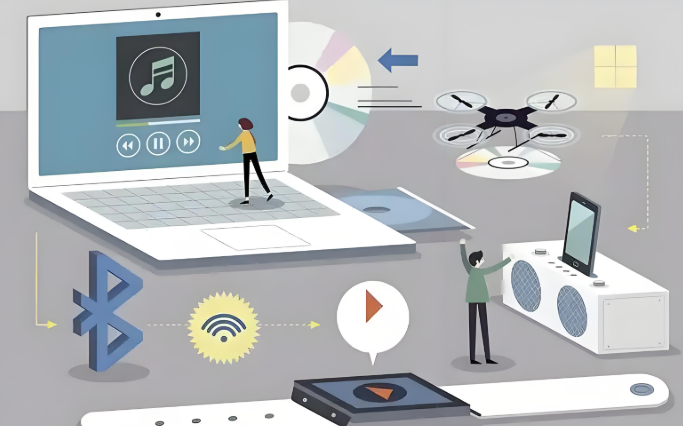Since its introduction in 1999, Bluetooth technology has become a core standard for short-range wireless communications worldwide, widely used in headphones, speakers, smart home devices, wearables, and more. However, users often question its performance due to the stereotype that "Bluetooth transmission is slow." In reality, Bluetooth transmission speed is not a fixed value but changes dynamically with technological iterations, protocol optimizations, and usage scenarios.

Technology Iteration: The Leap from "KB/s" to "MB/s"
Increases in Bluetooth transmission speed are closely tied to version upgrades, with key breakthroughs focusing on optimizing the physical layer protocol and coding efficiency:
Early Versions (1.0-3.0):
Bluetooth 1.0 had a theoretical transmission rate of only 721KB/s and an effective rate of approximately 400KB/s, supporting only voice transmission. Version 2.0 introduced Enhanced Data Rate (EDR) technology, which, through Gaussian Frequency Shift Keying (GFSK) modulation, increased the theoretical rate to 3MB/s. Commercially available speeds reached 1.8-2.1MB/s, supporting full-duplex communication (e.g., simultaneous voice and file transmission). Although version 3.0 is billed as "High-Speed Bluetooth," it actually relies on Wi-Fi for data transmission, and its own speed hasn't been significantly improved.
Classic Bluetooth (4.0-5.4):
Version 4.0 integrates Classic Bluetooth, High-Speed Bluetooth, and Bluetooth Low Energy (BLE). While the speed of Classic Bluetooth is similar to 2.0, BLE was originally designed for low-power scenarios, with an initial speed of only 39 KB/s. Version 5.0 marked a key turning point, increasing BLE speeds to 180 KB/s-2 MB/s by introducing a 2 Mbps PHY modulation mode. It also supports a long-range mode (LE Coded PHY), maintaining a stable connection up to 1 km. Version 5.2 added the LE Audio protocol, using the LC3 encoder, to achieve higher audio quality at the same speed and support multi-channel audio streaming.
Future Direction (6.0 and Beyond):
Bluetooth 6.0 hasn't yet significantly increased speeds, but the introduction of Channel Sounding technology has improved positioning accuracy to centimeter-level and optimized audio transmission latency and security. Future versions may break through the speed bottleneck by utilizing millimeter-wave frequency bands or higher-order modulation technologies.
Protocol Differences: The "Dual Track" of Classic Bluetooth and Bluetooth Low Energy
The Bluetooth protocol is divided into two major branches: Classic Bluetooth and Bluetooth Low Energy (BLE), with distinct speed design principles:
Classic Bluetooth: Equal emphasis on speed and capacity
Classic Bluetooth uses 79 channels (1MHz bandwidth) and supports both asynchronous connectionless (ACL) and synchronous connection-oriented (SCO) link types. ACL links are used for data transmission, with a theoretical rate of 3MB/s, but in practice, due to limitations in frequency hopping algorithms and interference avoidance mechanisms, the effective rate is typically 1-2MB/s. SCO links are designed specifically for voice, with a fixed rate of 64KB/s and support for audio transmission at a 16kHz sampling rate.
Bluetooth Low Energy (BLE): Balancing Power and Speed
BLE uses 40 channels (2MHz bandwidth) and reduces power consumption by shortening connection intervals and optimizing data packet structures. Its speed gradually increases with version upgrades:
BLE 4.0/4.1: 39KB/s (base rate)
BLE 4.2: 100KB/s (supports LE Data Length Extension)
BLE 5.0: 180KB/s (1Mbps PHY) to 2MB/s (2Mbps PHY)
BLE 5.1/5.2: The speed has not increased, but the LE Audio protocol optimizes audio transmission efficiency.
BLE speed design must balance power consumption. For example, in 2Mbps mode, device power consumption increases by approximately 50% compared to 1Mbps mode, but transmission time is cut in half, potentially lowering overall energy consumption.
Practical Limitations: From Theory to Reality: "Speed Decay"
Even though Bluetooth technology has achieved MB/s-level speeds, users may still experience slow transmissions due to multiple practical limitations:
Device Compatibility:
When different Bluetooth devices are used together, the speeds are backwards compatible. For example, when a Bluetooth 5.0 device connects to a Bluetooth 4.2 device, the speed is limited to 100KB/s. Furthermore, some manufacturers may reduce high-speed modules to reduce costs, resulting in actual speeds lower than theoretical values.
Physical Interference:
Bluetooth uses the 2.4GHz ISM band, sharing spectrum with devices such as Wi-Fi, microwave ovens, and cordless phones. In complex electromagnetic environments, signal interference can increase retransmission rates and reduce speeds by 30%-50%. Obstacles such as walls and metal objects further weaken signal strength, reducing the effective transmission range to less than 5 meters.
Data Packets and Transmission Methods:
Bluetooth supports both synchronous transmission (such as audio) and asynchronous transmission (such as file transmission). Synchronous transmission requires real-time performance, has smaller data packets, and a fixed transmission interval, resulting in lower speeds than asynchronous transmission. For example, transferring a 10MB file might take 10 seconds asynchronously, while synchronous transmission might take 15 seconds.
Device Performance Bottlenecks:
The quality of the Bluetooth module in devices such as mobile phones and computers directly affects speeds. Low-end modules may use a single antenna design with weak signal processing capabilities, resulting in unstable speeds. High-end modules use multiple antennas and MIMO technology to improve throughput.
The truth about Bluetooth transmission speed is that it has never pursued "the fastest," but rather sought the optimal balance between speed, power consumption, cost, and compatibility through technological iteration and protocol optimization. For audio devices like headphones and speakers, a speed of 1MB/s is sufficient for lossless audio transmission. For smart homes and wearable devices, low power consumption and stable connections are more important than speed. Bluetooth's speed disadvantage only becomes apparent when transferring large files, such as videos.